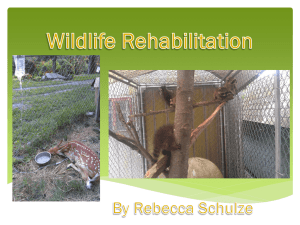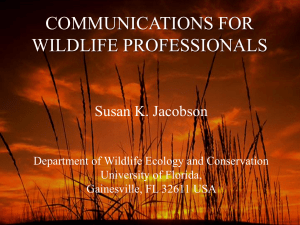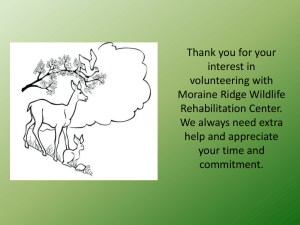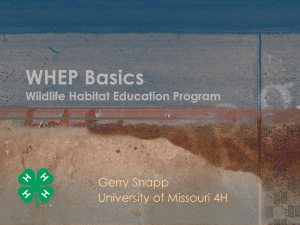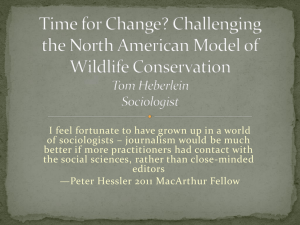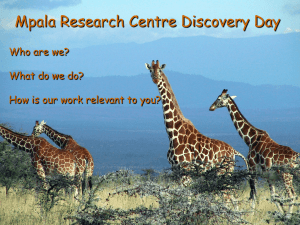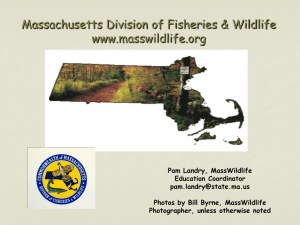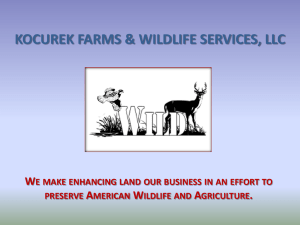Breeding and Non-breeding Survival of Lesser Prairie
advertisement
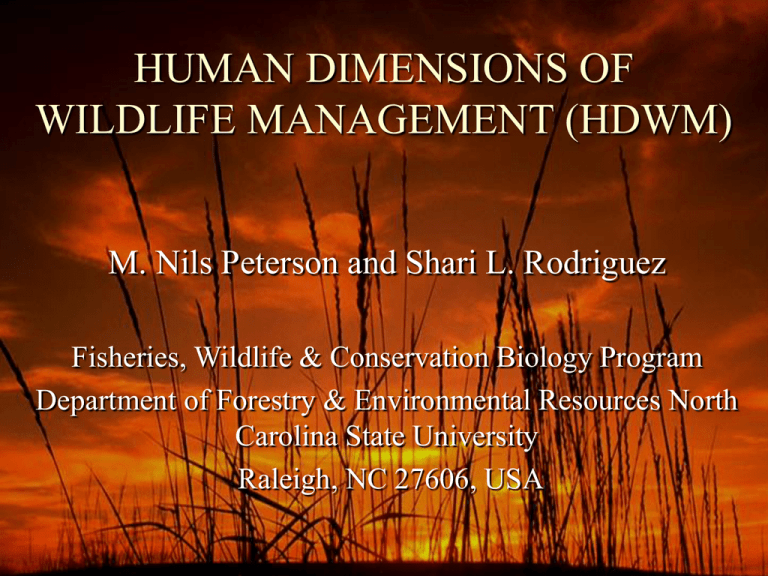
HUMAN DIMENSIONS OF WILDLIFE MANAGEMENT (HDWM) M. Nils Peterson and Shari L. Rodriguez Fisheries, Wildlife & Conservation Biology Program Department of Forestry & Environmental Resources North Carolina State University Raleigh, NC 27606, USA HDWM ► Portions of wildlife management that focus on the interactions between people and wildlife or between people regarding wildlife Imperatives for HDWM ► Professional ► Moral ► Learning from constituents ► Investing in social capital ► Contributing to long term conservation solutions Exercise ► What skills and abilities will you need to avoid becoming an “idiot savant wildlife manager?” See: Jacobson, S.K. and M.D. McDuff. 1998. Training idiot savants: The lack of human dimensions in conservation biology. Conservation Biology 12(2): 263-267. Cutler, M. R. 1982. What kind of wildlifers will be needed in the 1980s? Wildlife Society Bulletin 10: 75-79. The Evolution of HDWM ► The client model Sportspersons paid for & received services from wildlife managers ► The stakeholder model Identifying stakeholders, incorporating their input into decision-making, resisting special interest groups, weighing stakeholder opinions, & employing effective communication strategies ► The citizen model Adding duties associated with citizenship to the entitlements associated with being a stakeholder Social Structural Approaches ► Political economy Addresses how production, buying, selling and governance interact to shape society ► Biological basis of human interactions with wildlife Humans as hunters ► Humans are preprogramed for inter- & intra-specific aggression due to selection for hunting success Humans as hunted ► Natural selection makes people fear wildlife because humans were historically hunted by large carnivores before becoming hunters themselves Biophilia ► Humans have an instinctive bond with living systems Social Structural Approaches ► Coupled human-natural systems modeling The simulation of human society, its environment and interactions between the two systems using physical or mathematical models ► Economic valuation The act of assigning value to an object Often involves determining the potential market value of an object Social Psychology ► Attitudes Positive or negative evaluations of an object which include affective and cognitive dimensions ► Values Assigned value – meaning, goodness or worth placed on an object Held value – beliefs formed early in life that differentiate good from bad and are difficult or impossible to change ► Value orientations Basic beliefs a cultural group brings to bear on decision making Social Psychology ► Behavior An individual’s conscious or involuntary action or reaction to an object or environment ► Models for predicting behavior towards wildlife The norm-activation model Rational choice models ►Theory of Reasoned Action (TORA) ►Theory of Planned Behavior Social Psychology ► Risk Studies The study of actions or events that may lead to consequences harming people or things humans care about dimension – applies to risks that are nonobservable, new, unknown to those exposed, have delayed effects and lack scientific knowledge about them ►Dread dimension – applies to risks that are uncontrollable, dreaded, catastrophic, fatal, difficult to reduce, pose risk to future generations, demonstrate increasing levels of risk and have involuntary exposure ►Unknown Descriptive Research ► Quantitative examinations of populations or phenomenon “What”, “where”, “when”, and “how much” questions Philosophy ► Ethics Philosophy that provides the moral justification for wildlife management decisions ► Justice Philosophy associated with the distribution of benefits and costs associated with wildlife management ► Science Philosophy of the norms, methods, and biases of wildlife science Public Involvement ► How to Use Public Involvement Trinity of voice theory – sufficient opportunity for public to express opinions ►Standing – respect & legitimacy given to public perspectives ►Influence – public’s ideas are considered in the management decision ►Access Public Involvement ► When to Use Public Involvement Decision tree (Fig. 23.3) Decision tree for selecting public involvement methods for wildlife management decision making, adapted from (Lawrence and Deagen 2001). Qualitative Approaches “How” and “why” questions Emic perspective ►A description of human behavior or belief that comes from within the culture Ethnomethodology, focus groups, participatory action research, long interviews Most useful social knowledge comes from qualitative inquiry Qualitative Approaches Credibility emerges from: triangulation, informant validation, larger numbers of informants, longer time in the field, and using the actual words of informants Criteria for evaluating quantitative research Criteria for evaluating qualitative research internal validity credibility external validity transferability reliability dependability objectivity confirmability SUMMARY ► Future wildlife managers need HDWM skills more than any other type and have since the 1980s ► HDWM is evolving from providing a service for hunting groups to facilitating partnerships with diverse stakeholders ► Several key HDWM research programs ranging from social psychology to philosophy inform modern wildlife management ► Public participation is a powerful wildlife management tool, buts its success depends on careful consideration of 6 dimensions of social context


